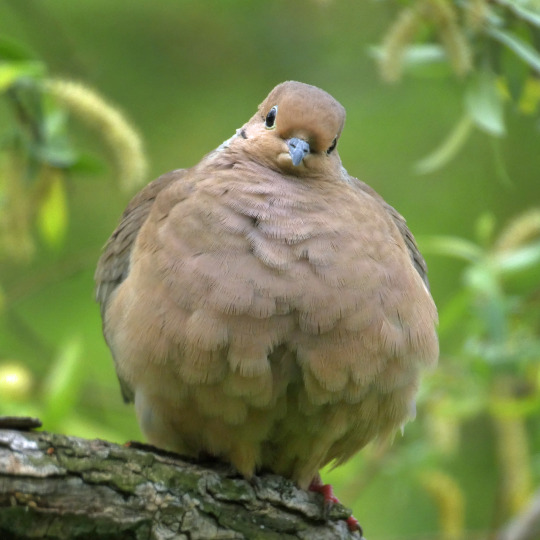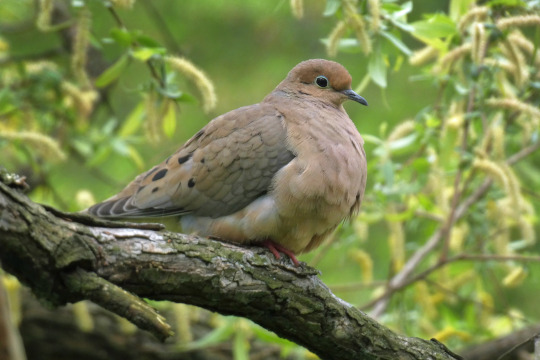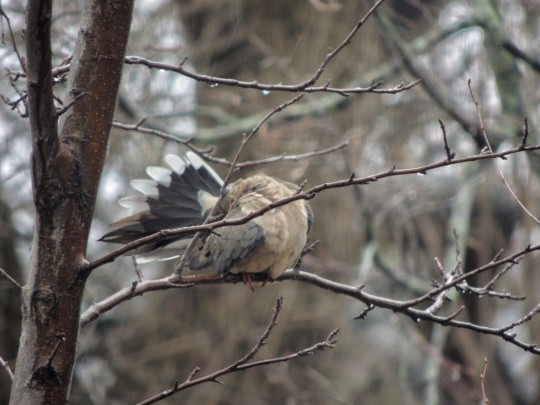#zenaida macroura
Explore tagged Tumblr posts
Text

Day 3: Mourning dove
579 notes
·
View notes
Text

Simplified bird #8 - mourning dove
( requested by anon )
#quite a couple other people requested this too i think#simplified birds#mourning dove#dove#doves#art#bird#bird drawing#birds#drawing#doodle#Zenaida macroura
553 notes
·
View notes
Text


Mourning Dove (Zenaida macroura)
May 3, 2023
Southeastern Pennsylvania
#bird#birds#photographers on tumblr#mourning dove#Zenaida macroura#birdblr#birblr#birb#birbs#borb#borbs#nature#animals#ornithology
3K notes
·
View notes
Text

Mourning dove / huilota común (Zenaida macroura), nesting in an ornamental cherry tree, Sierra Vista, Arizona.
217 notes
·
View notes
Text
BOTD: Mourning Dove

Photo: Mick Thompson
"The mournful cooing of the Mourning Dove is one of our most familiar bird sounds. From southern Canada to central Mexico, this is one of our most common birds, often abundant in open country and along roadsides. European settlement of the continent, with its opening of the forest, probably helped this species to increase. It also helps itself, by breeding prolifically: in warm climates, Mourning Doves may raise up to six broods per year, more than any other native bird."
- Audubon Field Guide
#birds#mourning dove#birds of north america#north american birds#doves#birds of the us#birds of canada#birds of mexico#birds of central america#birds of the caribbean#birding#birdblr#birblr#bird of the day#bird watching#Zenaida macroura
147 notes
·
View notes
Text

Mourning Dove (Zenaida macroura), taken June 28, 2024, in Georgia, US
Pondering, I believe. Sometimes life is just sitting on the edge of the bird bath and overlooking the koi pond a few feet ahead.
26 notes
·
View notes
Text

Mourning Dove
159 notes
·
View notes
Text


This photo of a mourning dove on a rusty fence was snapped in California. I always find them particularly striking against rusty metal. My favorite thing about them is their little beauty mark. <3
Mourning doves are intricately intertwined with the history of dove hunting in the US— and thanks to the Migratory Bird Treaty of 1918, is unlikely to go the way of the endemic American passenger pigeon. Dove hunting, as popular as it is, led to those regulations around it being clarified in 1999.
Another one of my favorite mourning dove facts— their wings whistle when they take off!
P.S. You can find this pixel art bird design as a sticker here. :3
#mourning dove#zenaida macroura#birdwatching#their call is also often mistaken for an owl#pixel art#bird art#image description in alt
14 notes
·
View notes
Note
Thoughts on making the Mourning Dove the new State Bird in Ohio? Sorry if this isn't a good bird for Ohio, I'm not too good at birds.

Thanks for the question! And no worries; all suggestions are welcome, and nothing's off the table!
Y'know, it's funny. I've always loved Mourning Doves (Zenaida macroura), personally. They're extremely common and recognizable (by sight and sound), they're found in urban and suburban environments, and they're generally charming. When I moved back to the continental USA as a kid, this was one of the first birds I recognized. But is it Ohio? At first blush, I would say that it's about as valid as the present state bird, the Northern Cardinal (Cardinalis cardinalis), in that it's a recognizable backyard bird that would probably be received positively by the public. So, hey, maybe it could work, but I'm not sure it's the best fit.
However. There is an argument to be made, in a very...odd way. Because if we want to use the state birds to tell a conservation story, and we want to tell a story in Ohio in particular...there is a story to be told for a different species. But to tell it, we would have to use the Mourning Dove. And that's because...

...the Passenger Pigeon (Ectopistes migratorius) is very VERY extinct. OK, is this cheating? Kind of. Obviously, this isn't a species of conservation concern...anymore. BUT!!! It's an important story about how humanity can drive even an extremely common species into extinction. But why use this for Ohio? After all, some of the last wild individuals were reported in Indiana, not Ohio. However, the last Passenger Pigeon EVER was Martha, a pigeon living in the Cincinnati Zoo until 1914, when she passed away some years after her mate did in the same zoo. So, in a very real sense, the story of the Passenger Pigeon ends in Ohio, and her legacy can be carried out by the only native pigeon species that breeds in the state, the Mourning Dove.
So, hey, there's an argument there for the Mourning Dove to be Ohio's state bird, outside of its recognizability and status as a common backyard bird! Do I think it's the ideal choice? Well, I don't know, honestly. I have yet to look into Ohio in more detail, but it's not impossible! Plus, thank you for bringing this up to me, because I may not have thought of it otherwise! Oh, and for the record, if you're interested in Martha, you can still see her! After her death, she was sent to the Smithsonian Institute in Washington D.C., where she's currently on display in the Objects of Wonder exhibit at the National Museum of Natural History! But I'd go finder her there soon; the exhibit closes in 2025, and who knows when and where she'll go on exhibit again after that!
But I'll remember this question when I get to Ohio, and I'll bring this idea up! We'll see what others think about it; maybe they'll agree!
#bird#birds#birdblr#bird tumblr#mourning dove#zenaida macroura#passenger pigeon#state bird initiative#state bird#birding#birders#birdwatchers#birdwatching#columbiformes#columbidae#doves#dove#pigeons#pigeon#ectopistes migratorius#extinct animals#extinct birds#martha#cincinnati zoo#national museum of natural history#smithsonian#ohio
7 notes
·
View notes
Text




Mourning Dove
Virginia, February 2024.
14 notes
·
View notes
Text

8 notes
·
View notes
Text

A mourning dove taking a shower in early April rain :)
2024
7 notes
·
View notes
Text
hrmm I think I may photo dump a small amount of critters











From left to right
First row: Fledgeling northern mockingbird, Florida predatory stinkbug, forest scaly cricket
Second row: Mourning Dove pair, groundhog, northern cardinal
Third row: Northern Mockingbird, a pair of bluebirds, which checked out the birdhouse we put up but didn’t actually nest in 😔, house finch
Fourth row: Eastern cottontail and a Carolina wren that vibed on our deck for a bit
#northern mockingbird#mimus polyglottos#florida predatory stink bug#Forest scaly cricket#mourning dove#zenaida macroura#Groundhog#eastern bluebird#sialia sialis#northern cardinal#cardinalis cardinalis#house finch#my photos#photography#carolina wren#eastern cottontail#birds#rabbit
3 notes
·
View notes
Text


Nesting mourning dove / huilota común (Zenaida macroura) at Tohono Chul.
The nest is visible in the upper-right of the bottom photo. To me the nest looked precariously situated, balanced on a flat bismarckia palm frond, but it was apparently secure and successful. Mama dove was warming two very new hatchlings tucked under her breast. Desert mornings can be cold! I opted not to disturb them just for the sake of a photo.
#photographers on tumblr#mourning dove#Zenaida macroura#bird#nest#Bismarckia nobilis#Tohono Chul#Casas Adobes#Tucson#Arizona
166 notes
·
View notes
Text
Mourning Dove (Zenaida macroura)

"Pretty and I love them"
Other names include: American mourning dove, the rain dove, turtle dove (not the popular one), as well as Carolina pigeon and Carolina turtledove.
This is one of the most populous birds in North America, and is a popular game-bird. Typically up to 20 million are taken annually as game, and their numbers continue to remain stable despite that- wild! Part of this is that the Mourning dove is a prolific breeder, and can have up to six broods of two young in the warmer portions of their range.
Let me tell y'all... these are the softest things in the world. They're incredibly hard to hold in hand due to the fact their neck can scrunch up real short, they've got itty-bitty legs to hold on to, and the softness of their feathers makes them very slippery. Adding onto that, mourning dove will lose some of their body feathers as a way to escape predation. It works almost like slipping your hand from a glove, with the shed feathers becoming stuck in a predators mouth or grasp while the bird wiggles out and flies away. This can make a dove escape look fairly dramatic.
Source:
Image source: eBird - Nancy Christensen
26 notes
·
View notes
